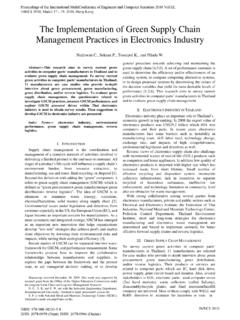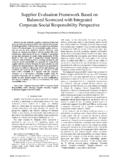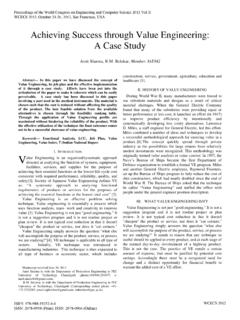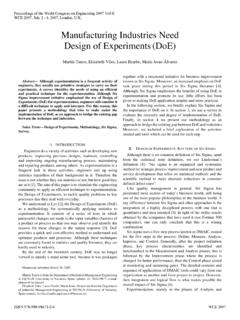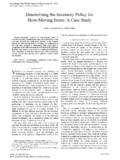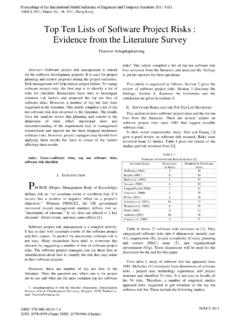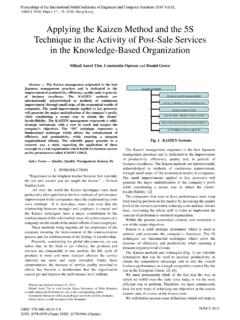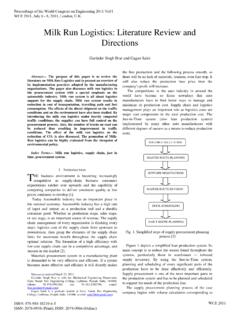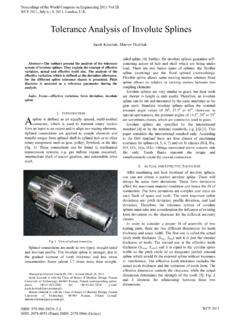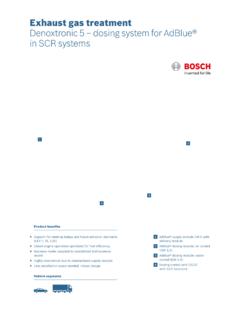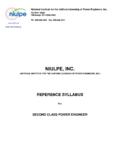Transcription of Effect of Boost Temperature on the Performance …
1 Abstract Consequently, an experimental research program has been conducted on many aspect and parameters to evaluate the Performance and emissions characteristic of unmodified common-rail diesel engine operating with biodiesel. Conventional twin turbo V6 diesel engine has been used on this research where the modern technologies equipped to the engine including exhaust gas recirculation (EGR), variable geometry turbine (VGT) and common rail fuel injection systems. In this research report, the Effect of Boost air Temperature has been investigated at low and part load as a key parameter that possibly affect the combustion of RME due to EGR operations, VGT as well as the change of charge air density.
2 The results have been carefully revise and the analysis are includes in-cylinder pressure, rate of heat release, fuel injection parameters as well as emissions level. The overall results have shown that Boost air Temperature has significantly affected the Performance as well as emissions of the engine especially at high load. The in-cylinder peak pressure is increase as Boost air Temperature increase resulted to increase NOx emissions. Key words: Boost Temperature , diesel engine, rapeseed methyl ester I. INTRODUCTION It is apparent that the engines power decreases as the air intake mass flow rate diminish.
3 In diesel engine, supercharger or turbocharger is widely used to increase air flow rate to the engines, and hence the volumetric efficiency. Many researches have been conducted on the Effect of charge Temperature to diesel engine [1-3]. Moreover, the Effect of charge air intake is extremely important to the recent development of HCCI engines worldwide [4-9]. The properties of air that affect the mass flow rate is among others is the density of air which is linked to the air Temperature . The volumetric efficiency is increased as the charge air Temperature reduces. However, the increase of charge air Temperature is in another way could possibly improve the fuel vaporisation in engine cylinders.
4 This is extremely important for the diesel engine operating with biodiesel. Many researches have been conducted to explain the Effect of fuel vaporisation for biodiesel. Biodiesel is consists of the mono alkyl esters of vegetable oils and animal fats. The different in chemical structure demonstrates distinctive Manuscript received March 2, 2010. Rizalman Mamat with Universiti Malaysia Pahang, 25000 Kuantan, Malaysia, Tel: 609-424 2303 e-mail: Nik Rosli Abdullah, Hongming Xu, Miroslaw L. Wyszynski, A. Tsolakis with University of Birmingham, B15 2TT Edgbaston, Birmingham, United Kingdom, e-mail: impacts on the chemical reaction pathways during ignition and combustion [10].
5 The increase of inlet Temperature promoted to the reductions of in-cylinder trap mass (thermal trottling Effect ). Therefore, the capacity of oxygen and heat capacity of air charge significantly reduced. Many researches have been conducted on the Effect of charge air inlet Temperature on diesel engines. Maiboom et al. has conducted a series of experiment on inline-4 diesel engine[2]. The engine was equipped with cooled EGR system, common-rail injection system and VGT. The engine was operated with mineral diesel fuel at constant engine speed, EGR ratio and inlet Boost pressure.
6 The charge inlet Temperature was varied from 20oC to 38oC. He concluded that the increase of inlet Temperature at constant Boost pressure results in a slight decrease of the ROHR. He suggests that at constant Boost pressure, the fuel jet entrains less air with reduced in-cylinder gas density, resulting in a lower oxygen-fuel mixing therefore lower ROHR. Torregrosa et al. constructed a fully controlled diesel engine to study the influence of inlet air charge Temperature on the Performance and emissions of a diesel engine. The intake temperatures were varies but the coolant Temperature was controlled to isolate the Effect of cylinder walls Temperature Effect .
7 The report concludes that the increase of intake Temperature results to increase NOx emissions. RME has a higher tendency to form fuel rich zones at low load conditions than the other fuels due to higher viscosity and fuel distillation curves [11]. In addition, RME has a possibility of poor fuel atomization and vaporization, due to higher density, kinematic viscosity and distillation Temperature than those of diesel fuel [12]. A research conducted by Stovell on a spark ignited natural gas engine also suggest that the small change in air intake Temperature have changed the engine response, Performance as well as exhaust gas emissions [13].
8 He used to test with three different intake air temperatures (50oF, 80oF and 130oF) to evaluate their impact upon engine Performance and emissions. Therefore, this paper is intends to figure out this phenomenon and their Effect on the progress of combustion quality as well as emissions on a conventional V6 diesel engine. The studies are focused on the details of engine response into the Effect of Boost Temperature . Effect of Boost Temperature on the Performance and Emissions of a Common Rail diesel Engine Operating with Rapeseed Methyl Ester (RME) Rizalman Mamat, Nik Rosli Abdullah, Hongming Xu, Miroslaw L.
9 Wyszynski, A. Tsolakis Proceedings of the World Congress on Engineering 2010 Vol II WCE 2010, June 30 - July 2, 2010, London, : 978-988-18210-7-2 ISSN: 2078-0958 (Print); ISSN: 2078-0966 (Online)WCE 2010 II. EXPERIMENTAL SET-UP The experimental work was performed on a V6 diesel engine. The engine was water-cooled, fitted with a high pressure direct fuel injection system from common rail and equipped with twin variable-geometry turbine (VGT) turbochargers and a cooled exhaust gas recirculation (EGR) system. Details of the engine are described in Table 1. Figure 1 shows the photograph of the test engine used in this study.
10 An eddy-current water-cooled Schenck dynamometer model W230 with a series S2000 control system was used to load the engine. The in-cylinder pressure was measured by piezometric glow-plug high pressure transducers supplied by AVL, with model number AVL GU13G wired to AVL Piezo Amplifiers model 3066A03 where pressure was read at crankshaft positions recorded by a shaft encoder. The piezo sensor used has a sensitivity of 15pC/bar. Both data series (pressure and crank angle degrees) were recorded through a National Instrument data acquisition system NI PCI-6023E installed in a Windows XP - based PC. Pressure was measured in cylinders 2 and 5 as depicted in Figure 2.
